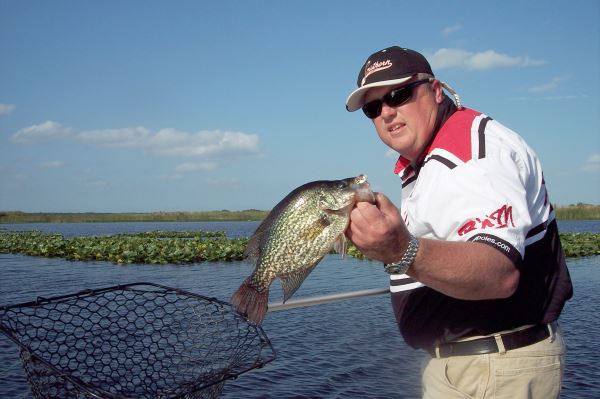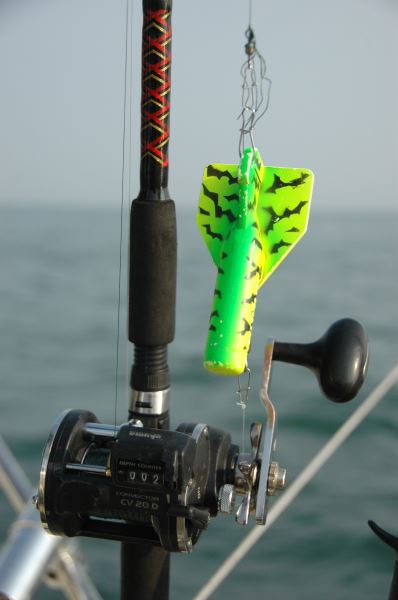
This article originally appeared in the August 2015 issue.
With their broad transoms and stable nature, pontoon and deck boats are excellent platforms from which to troll—a mobile method of fishing that involves towing baits from a boat that is under power by a main engine or auxiliary motor made for the slow speed task. But as wide as those line presentations are, they can be spread even farther by deploying a few angling accessories to force lines out to the side and to get offerings deep—one, the other, or both of which are often key to fooling late-summer gamefish.
Many popular gamefish such as bass, walleyes, crappie and salmon will spend the warmer summer months suspended out in open, where they will move out of the path of an approaching boat. These fish may miss seeing or choose to ignore any lures that may be following in its wake. Others may be pushed deeper into the water column by the commotion, joining a population of gamefish that remains in the deeper, cooler depths.
Getting Out

You can cover a broader swath of water from any pontoon or deck boat by simply placing a fishing rod in each transom corner in a rod holder set to angle the rod out and away from the side of the boat. To reach out even farther, you can use in-line planer boards snapped onto the line above the lures or baits being trolled. The wedge-shaped plastic boards clamp onto the fishing line anywhere from 20 to 75 feet above the bait, and the water pressure against the planer’s angled face as it is dragged forward by the boat forces the board and the trailing line far off to the side. When a fish strikes, the board tips backward and/or a spring-loaded flag trips and pops up to signal a hookup. At that point the line is reeled in to allow the angler or a partner to unclip the board and the fisherman fights and (hopefully) lands the catch.
Getting Down
 The same planing principles can be used to get trolled baits deep without use of excessive weight. Several types of divers are available that are designed to drag baits deep using the shape and angle of the plastic devices that are spliced on the line above the lures. The Luhr-Jensen Jet Diver (www.luhrjensen.com) is a popular model, as is the Davis Fish Seeker (www.davisnet.com) and TripZ Diver (www.walkerdownriggers.com). Most divers float at rest, and act more as an oversized lip on a deep-diving crankbait relying on angle alone to drag baits down when pulled forward by the boat. They also track directly behind the boat, so don’t do anything to spread the lures out to the side.
The same planing principles can be used to get trolled baits deep without use of excessive weight. Several types of divers are available that are designed to drag baits deep using the shape and angle of the plastic devices that are spliced on the line above the lures. The Luhr-Jensen Jet Diver (www.luhrjensen.com) is a popular model, as is the Davis Fish Seeker (www.davisnet.com) and TripZ Diver (www.walkerdownriggers.com). Most divers float at rest, and act more as an oversized lip on a deep-diving crankbait relying on angle alone to drag baits down when pulled forward by the boat. They also track directly behind the boat, so don’t do anything to spread the lures out to the side.
One trolling accessory combines shape and weight to get baits down deeper than weight or shape alone can muster. The Tadpole by Off Shore Tackle (www.offshoretackle.com) is a trolling sink/planer that, like other planers, is tied between the main line and the lure. The combination of its angled shape and lead weight drives it deep; when a fish strikes the lure it trails the angle of pull changes at the line attachment point and the diver and its catch can be brought to the surface without resistance from the planer.
Getting Down & Out
One diver does both: taking baits out to the side and down deep using an angled surface that even offers some erratic movement to the baits it trailers several feet behind. The Dipsy Diver, by Luhr-Jensen, is disc-shaped and relies on weight, size, shape and line angle to take lines down and out to the side of the boat, where they impart an action that many fish find especially appealing. Dipsy Divers also have settings that can regulate their depth and the angle at which they dive. On setting 0, the Dipsy dives straight down; on a three setting, the same disc will take a lure out 50 feet or more to the side of a boat. The settings allow anglers to troll multiple additional lines, flat or with Jet Divers or lead-core line, between a pair of Dipsy-trolled baits.
Divers of all types are attached directly to the end of the fishing line with ball-bearing snap swivel followed by the diver then a leader of 3 to 10 feet or more attached to the lure—which can be anything from a traditional nightcrawler harness or common crankbait to a colorful spoon. As with any style of trolling, the key to success is trying to match the size of the lure to the predominant prey, and then varying the speed and the direction of the trolling to get the lures into the feeding zone or trigger reaction strikes. This time of year, getting those baits down and out and away from the boat may make the difference between trolling and catching.
Know Thy Thermocline
High air temperatures heat surface and subsurface waters beyond the comfort range of most fish, which this time of the year seek cooler waters in search of comfort, food and oxygen. The fish and the bait they follow are limited to how deep they can go in most lakes and reservoirs during the summer months by a barrier called the thermocline, below which there is little oxygen and water temps take a dramatic nose-dive. The thermocline layer may begin at depths as little as 10 feet or as deep as 70, but wherever it sets up this time of year it represents a transition area that prey fish will cruise, in hopes of finding baitfish. The thermocline will show up on most fish finders as a line, but you may have to tweak your unit a bit to get it to be defined. Once located, trolling baits just above the thermocline is a proven tactic for locating active gamefish.

